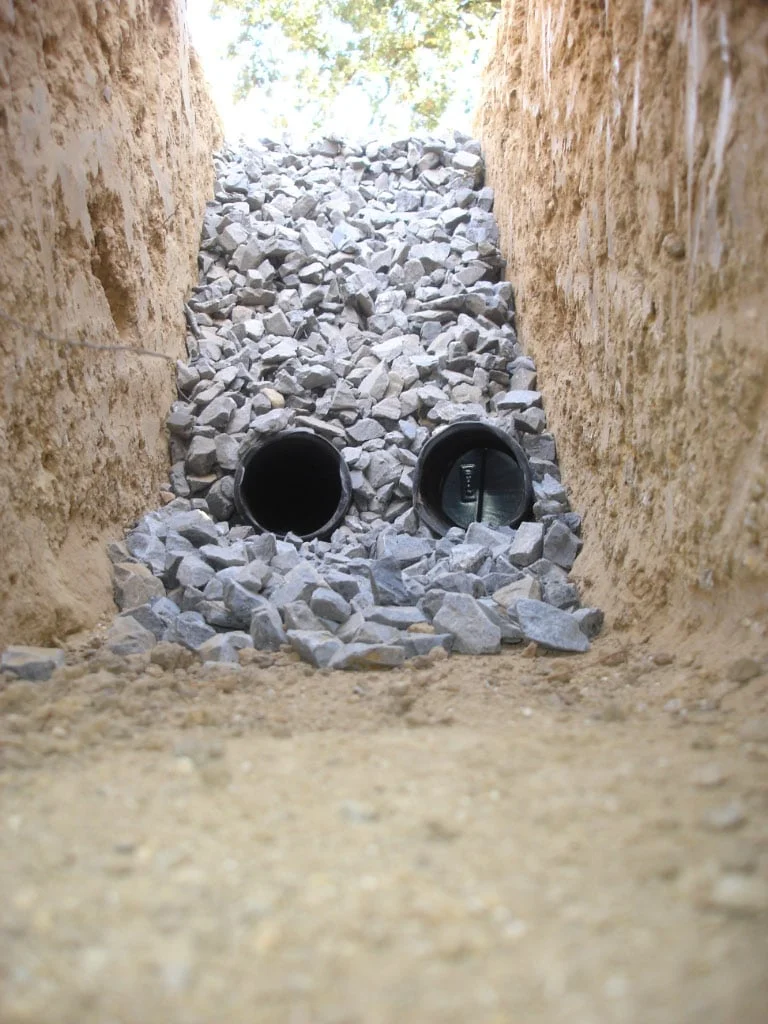
JC Landscaping Professionals installs french drains in Pensacola Florida & surrounded areas. Just give us a call and we’ll send someone out right away to both inspect your property and provide you with a free estimate.
WHAT ARE FRENCH DRAINS?
A french drain is just a slightly sloped ditch, a pipe with holes in it, and some gravel. Nothing fancy. French drains take advantage of the fact that water flows downhill via the path of least resistance. The perforated pipe collects water, channels it away from foundations or other low spots on your property, and deposits it elsewhere.
You can think of french drains as gutters for groundwater. When it rains, all that water has to go somewhere. It might soak into your foundation resulting in a wet basement or pool on your property causing soggy spots here and there on your lawn. French drains simply collect the water and move it to another location. Your basement dries out and the soggy spots disappear.
ARE FRENCH DRAINS EFFECTIVE?
Yes, french drains have been around for a long time and are a popular method for channeling water away from your home or property.
HOW DO FRENCH DRAINS WORK?
The concept behind a french drain is simple. When it rains, the water flows through the gravel and into the perforated, slightly-sloped pipe. It then travels down the pipe and exits at a predetermined location. For example, a storm drain or another area of your property. French drains are about moving water from one location (where you don’t want it) to another.
WHY YOU MIGHT WANT TO USE A FRENCH DRAIN
French drains are great for moving groundwater away from your home or property. Common scenarios include…
- Wet basements caused by waterlogged foundations – Groundwater pushing up against your home’s foundation will eventually find its way inside. The result is a wet basement or even flooding. French drains are a great way to reroute water away from your foundation.
- Soggy lawn spots – Water can pool in certain areas and cause soggy spots. A french drain installed below the soggy location can collect the water and channel it elsewhere. These french drains are often shallow, usually no more than a couple of feet deep.
- Your’e building a retaining wall – Retaining walls are common in landscaping projects and are used as a way to create attractive terraces and planting beds. The problem is they are impervious to water. Water weighs 62.4 lbs per cubic foot. If you don’t provide a way for the water to drain, it will press up against the wall and could eventually cause it to buckle or crack. To prevent this from happening, excessive water pressure (hydrostatic pressure) should be minimized adjacent to both retaining and basement walls.
FRENCH DRAINS VS SWALES
French drains are similar to swales and you might hear the terms ‘french drain’ and ‘swale’ used interchangeably. However, they are not the same thing. A swale is just a sloped ditch filled with gravel. It does not contain a perforated pipe. However, it works the same way. The water enters the gravel-filled ditch and then travels through it until it finds the exit.
French drains use perforated pipe along with gravel. The perforated pipe collects the water and channels it to a predetermined deposit point.
INSTALLING FRENCH DRAINS
When it comes to installing a french drain there are several basic steps,
- Remove a layer of sod equal to the width and length of the trench you’re going to excavate.
- Excavate the trench. The depth and width of the trench will vary depending on the existing conditions and design of the structure but will generally be at least 12 inches wide and 18-24 inches deep.
- Cover the trench with special, water-permeable drainage geotextile fabric. This filter wrap keeps the crushed stone separate from the soil which keeps the pipe from getting clogged with debris. If this is done properly, the french drain should be maintenance-free.
- Place the perforated pipe (PVC or flexible with slits) into the fabric-lined trench.
- Cover the pipe with crushed rock or stone.
- Wrap the rock or stone with the geotextile fabric.
- Install fill to proper grade.
- Replace the sod.
MAINTAINING FRENCH DRAINS
While a properly installed french drain shouldn’t need any maintenance once it’s in place, there are a few things every property owner should be aware of…
- French drains can clog up with debris over time. Yes, the water-permeable drainage fabric greatly reduces the chance of this happening. However, it still occurs from time to time. In most cases, the obstruction can be viewed via a CCTV video inspection and then a solution such as hydro jetting can be used to clear it.
- The pipes used in french drains can be damaged by construction equipment or other vehicles moving over them. Therefore, they’ll need to be placed in an area free of vehicle traffic.
- Like everything else in this world, groundwater conditions are subject to change. If this happens, your current french drain might not be enough to handle the load. You might need to install additional drains or even dig up and replace the one you have.
Our Services

